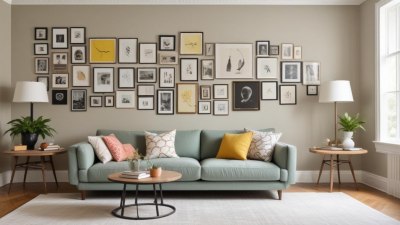Why You Always Want to Redecorate When the Season Shifts
Explore the psychological and environmental reasons behind seasonal redecoration habits.

This image was created with the assistance of Freepik
As the seasons change, many individuals feel a strong urge to redecorate their living spaces. This phenomenon is often tied to psychological factors, environmental changes, and cultural practices. As winter gives way to spring and summer turns into fall, the transition can prompt a desire to refresh our homes alongside nature’s rhythms. Understanding why this happens can help us better leverage this impulse to create more inviting and vibrant spaces.
The Psychological Roots of Redecorating
Psychologically, humans have a deep-seated connection to their environments. Our spaces impact our moods, productivity, and overall well-being. As seasons change, so do our emotional needs. For instance, during winter when days are short and sunlight is limited, many people may feel a sense of heaviness. Redecorating in the spring when sunlight returns can uplift spirits. The act of changing our environment can also serve as a form of self-expression, allowing us to reflect our current emotional state or aspirations. During seasonal transitions, the desire for change can signify a shift in mindset, encouraging individuals to align their physical surroundings with their evolving self.
Environmental Factors
Environmentally, seasonal changes bring noticeable shifts in light, temperature, and nature. Spring invites blooming flowers, longer days, and warmer weather, promoting an urge to open windows and let in brightness. Consequently, many feel inclined to swap heavy winter textiles for lighter fabrics. Similarly, fall’s arrival often brings a sense of coziness and warmth, prompting individuals to incorporate rich colors and textured decor into their spaces. The smell of cinnamon, the sight of amber leaves, and the touch of softer fabrics can instill a sense of comfort associated with the season. Even the air can feel different, inspiring a desire to adapt our surroundings to match the beauty of the outdoors and enhance the comfort of our living spaces.
Cultural and Social Influences
Culturally, many societies celebrate the change of seasons with rituals, events, and traditions that often involve home alteration. For instance, spring cleaning is a habitual practice in numerous cultures, symbolizing renewal and a fresh start. This cultural push can lead individuals to embark on decorating projects as a way to honor tradition and initiate personal transitions. Social factors, such as seasonal gatherings, holidays, and festivities, often influence home decor desires as well. During holidays, individuals wish to present their homes in accordance with seasonal aesthetics, encouraging them to modify spaces to accommodate celebrations. These factors combined create an overarching narrative in which the desire to redecorate becomes part of a larger seasonal experience.
Colors and Textiles: A Seasonal Palette
When it comes to decor, colors and textures are integral to establishing a seasonal atmosphere in one's home. Colors evoke emotions and set a tone for a room. Bright, vibrant hues may be favored during spring and summer to enhance feelings of happiness and energy. Conversely, earth tones and jewel tones during the fall and winter can foster a sense of warmth and comfort. Choosing the right textiles is equally important; seasonal fabrics can completely transform the ambiance of a space. Light, airy linens for summer can help center a feeling of relaxation, while heavier, cozier materials like flannel or wool provide comfort in winter. The strategic combination of colors and textiles not only reflects the seasons but also revitalizes a home, making it feel new and welcoming throughout the year.
Space Planning and Functionality
As seasons shift, the functional needs within a home often change as well. With longer days, relaxation spaces may become more inviting to enjoy indoor activities as families gather to savor the warmth. In contrast, as temperatures drop, spaces designed for warmth and togetherness become vital, leading to a reconfiguration of furniture or the introduction of new elements like plush throws and additional lighting. Individuals may find themselves wanting to create a sense of flow in a space that highlights seasonal activities, whether that means accommodating summer barbecues by optimizing outdoor spaces or rearranging the living room for cozy movie nights in winter.
The Influence of Trends
Trends also play a significant role in the desire to redecorate as seasons change. Every year, interior designers and influencers curate seasonal collections that set a tone for trending decor styles, colors, and themes. As new trends emerge, the allure to keep up with the changing design landscape can lead people to rethink their spaces. Following trends can also inspire individuals to take on new DIY projects, unleashing creativity as they reshape their environments. This interaction between societal updates and personal spaces becomes a dialogue that drives redecoration across changing seasons.
Budget Considerations
Budget plays a practical role in redecoration choices, specifically when looking to refresh a space for a new season. Those on a tight budget may find themselves integrating small changes: switching out decorative pillows, applying seasonal artwork, or altering lighting fixtures. These minor alterations can create significant visual impacts, allowing individuals to embrace the spirit of the season without overspending. In this way, seasonal redecorating is often viewed not just as an aesthetic choice, but a financial one that emphasizes accessibility and sustainability.
In conclusion, the strong desire to redecorate as the seasons shift is multifaceted, stemming from psychological urges, environmental cues, cultural traditions, and societal trends. The interplay between these elements encourages us to reflect, adapt, and invigorate our spaces to align with the world around us. As we embrace the seasons, we can lead lives that resonate with the changing environment and our evolving selves, transforming our homes into reflections of our experiences. Understanding this drive can empower individuals to welcome change into their lives, celebrating every seasonal transition through thoughtful and creative design decisions.











